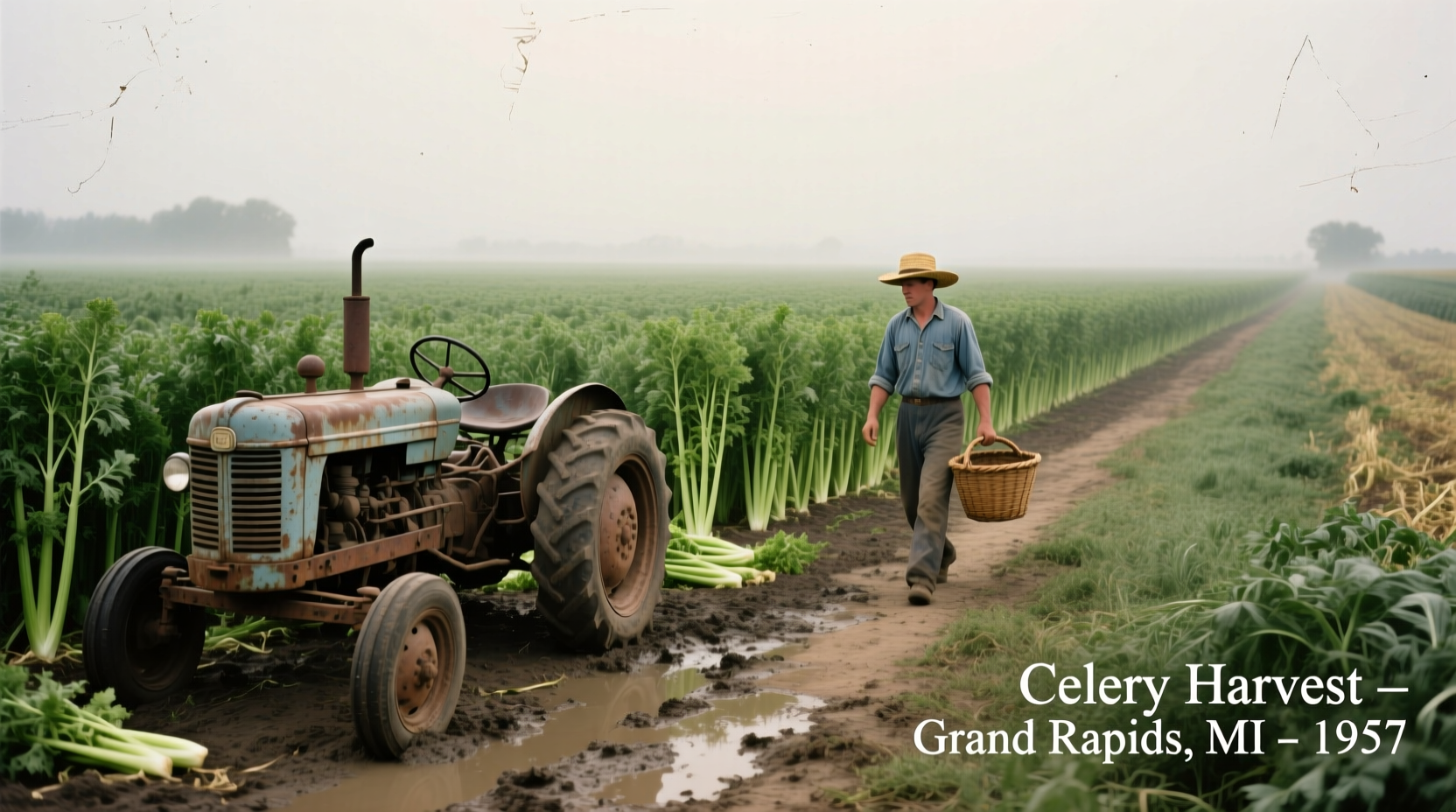Celery City is the historic nickname for Grand Rapids, Michigan, earned during the late 19th and early 20th centuries when the region produced more celery than any other place in the United States, at one point accounting for nearly half of the nation's commercial celery supply.
When you search for "celery city," you're likely curious about this unusual moniker and its historical significance. This article reveals the fascinating agricultural history behind Grand Rapids' distinctive nickname, exploring how a humble vegetable shaped an entire city's identity and economy for generations.
The Origins of Grand Rapids' Celery Boom
Grand Rapids earned its "Celery City" nickname through an agricultural phenomenon that transformed the region. In the 1880s, local farmers discovered that the area's unique combination of sandy loam soil, abundant river water, and favorable climate created ideal conditions for celery cultivation. What began as small-scale farming quickly evolved into a major industry that would define the city for decades.
By the early 1900s, West Michigan had become the celery capital of the world. The region's production was so dominant that at its peak around 1910, West Michigan growers produced approximately 17,000 acres of celery annually—nearly 50% of the entire United States commercial supply. This agricultural dominance wasn't accidental; it resulted from deliberate farming innovations and perfect environmental conditions.
| Time Period | Celery Production in West Michigan | Significance |
|---|---|---|
| 1880s | Initial commercial cultivation begins | First celery farms established along Grand River |
| 1900-1910 | 17,000 acres cultivated annually | Peak production; 50% of US commercial supply |
| 1910-1920 | 10,000-12,000 acres annually | "Celery City" nickname becomes widely recognized |
| 1930s | Sharp decline begins | Pink rot disease devastates crops |
| 1940s-1950s | Commercial production ends | Industry shifts to California and Florida |
Why Grand Rapids Became the Perfect Celery Growing Region
The success of celery farming in Grand Rapids wasn't merely coincidence—it resulted from specific environmental advantages that made the region uniquely suited for this crop. Unlike many vegetables, celery requires consistent moisture, rich soil, and protection from extreme temperatures, all of which the Grand River valley provided in abundance.
According to historical records from the Michigan State University Extension archives, the area's sandy loam soil provided excellent drainage while retaining sufficient moisture—critical for celery's shallow root system. The numerous rivers and streams offered reliable irrigation, while the lake-effect climate moderated temperatures, preventing the extreme heat that can cause celery to bolt or become stringy.
Local farmers developed specialized techniques that further enhanced production. They constructed extensive drainage systems to manage water levels precisely and created " celery beds" with raised rows that improved soil warming and drainage. These innovations gave West Michigan growers a competitive edge that lasted for decades.

How Celery Shaped Grand Rapids' Development
The celery industry didn't just give Grand Rapids a nickname—it fundamentally transformed the city's economic and social landscape. At the industry's peak, celery farming employed thousands of workers, including many immigrants who came specifically for seasonal work. The demand for labor spurred population growth and shaped the city's demographic makeup.
According to the Grand Rapids Historical Society, celery production required approximately 10,000 seasonal workers during harvest time. These workers came from diverse backgrounds, including Dutch, Polish, and Mexican communities, creating a multicultural workforce that enriched the city's social fabric. Many of these workers eventually settled permanently in the area, establishing neighborhoods that still exist today.
The economic impact extended far beyond the fields. Celery farming stimulated related industries including box manufacturing (for shipping), refrigerated transportation, and agricultural equipment suppliers. Banks developed specialized lending programs for celery growers, and the city's infrastructure expanded to accommodate the industry's needs.
The Decline of Celery Production in Grand Rapids
Despite its dominance, Grand Rapids' celery industry faced significant challenges that eventually led to its decline. The most devastating factor was pink rot, a fungal disease that began affecting crops in the 1930s. Unlike modern diseases that can be managed with fungicides, pink rot had no effective treatment at the time and could destroy entire fields.
Additional factors contributed to the industry's contraction:
- Competition from California and Florida, where year-round growing seasons reduced production costs
- Rising labor costs as workers organized and demanded better wages
- Changing agricultural practices that favored mechanization over labor-intensive crops
- Urban expansion that converted farmland to residential and commercial uses
By the 1950s, commercial celery production in the Grand Rapids area had virtually disappeared, though the "Celery City" nickname endured as a point of local pride and historical identity.
Celery City Today: Preserving a Unique Heritage
While commercial celery farming no longer exists in Grand Rapids, the city actively preserves its agricultural heritage through various initiatives. The Grand Rapids Public Museum features exhibits on the celery industry, including historical photographs, farming tools, and personal accounts from former celery workers.
Local restaurants occasionally incorporate the city's history into their menus, with some establishments offering "Celery City" specials that pay homage to the region's agricultural past. Though not a major festival, some community events still reference the celery heritage, particularly in neighborhoods with strong historical connections to the industry.
Perhaps most significantly, the nickname "Celery City" remains a beloved part of local identity. Residents proudly use the term in business names, community organizations, and informal conversation, ensuring that this unique chapter of Grand Rapids history continues to inform the city's character.
Understanding Celery's Historical Context in American Agriculture
The Grand Rapids celery story represents a broader pattern in American agricultural history where specific regions became dominant producers of particular crops based on environmental advantages and specialized knowledge. Similar regional specializations occurred with oranges in Florida, apples in Washington, and potatoes in Idaho.
What makes the Grand Rapids case particularly interesting is how completely the city embraced this identity. Unlike many agricultural regions that simply produce commodities, Grand Rapids integrated celery into its civic identity, with schools, businesses, and community organizations adopting celery-related names and imagery.
This phenomenon illustrates how agricultural production can shape not just an economy, but a community's entire cultural identity—a lesson that remains relevant as modern communities seek to define themselves through local food movements and agricultural heritage tourism.
Frequently Asked Questions
Why is Grand Rapids called Celery City?
Grand Rapids earned the nickname "Celery City" because it was the largest producer of celery in the United States during the late 19th and early 20th centuries, at one point accounting for nearly half of the nation's commercial celery supply.
When was Grand Rapids known as Celery City?
Grand Rapids was known as Celery City primarily from the 1890s through the 1930s, with peak production occurring around 1910 when West Michigan growers cultivated approximately 17,000 acres of celery annually.
What caused the decline of celery farming in Grand Rapids?
The decline was caused by pink rot disease that devastated crops starting in the 1930s, competition from California and Florida growers, rising labor costs, and urban expansion that converted farmland to other uses. By the 1950s, commercial celery production had ended in the area.
Does Grand Rapids still grow celery today?
No, commercial celery production ended in the Grand Rapids area by the 1950s. While some home gardeners may grow small amounts, the large-scale farming operations that defined the "Celery City" era no longer exist in the region.
How did celery farming impact Grand Rapids' development?
Celery farming transformed Grand Rapids by creating thousands of seasonal jobs, attracting immigrant workers who settled permanently, stimulating related industries like box manufacturing and transportation, and shaping the city's cultural identity, which still references its celery heritage today.











 浙公网安备
33010002000092号
浙公网安备
33010002000092号 浙B2-20120091-4
浙B2-20120091-4